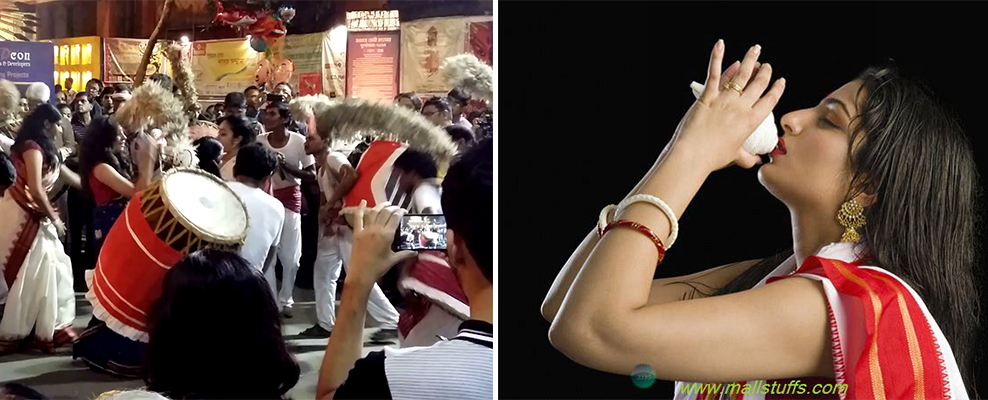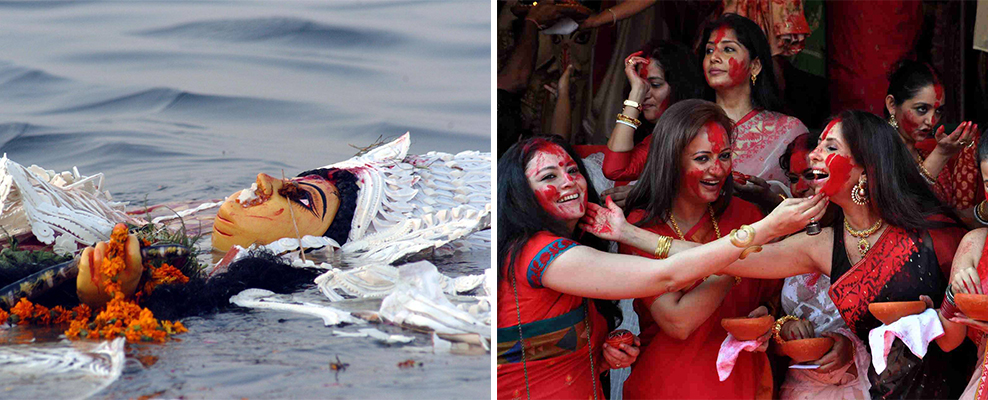
WoT's Hot
Durga Puja is a quintessential Hindu festival which is perhaps celebrated with the maximum pomp and vigor in Bengal. Maa Durga’s arrival is heralded by millions in a way that is unmatched anywhere else in the country. Durga Puja as we know is an annual event in September/October in the month of Aswin ushering in the auspicious time of the Mother. We hear all about Durga descending, riding on a horse or astride an elephant and so on. Yet again there are details as to way she returns to Mount Kailash, either on horseback, back of an elephant or carried on a palanquin. But seldom has the real reason outlining why she does so, been explained.
The explanation is fairly straight forward. Devi descends on Saptami tithi and returns to her abode on Dashami or Dussehra. If she descends on Monday, she departs on Thursday. If it so happens that Devi Durga’s scheduled descent on Earth on Saptami, is a Sunday or a Monday, then she arrives astride an elephant. On a Saturday, she prefers to be on horseback. Thursday and Friday, she chooses to take a palanquin. However on Wednesday her chosen mode is a boat. Similarly, her departure four days later will have the same pattern. Arrival Monday - Departure Thursday – then the modes will be elephant and palanquin. This is the rationale behind Devi Durga’s modes of transport for arrival and departure.
Similarly, another shloka indicates what is to happen on Earth when Devi Durga arrives and departs in her chosen mode of transport. If Devi arrives or departs astride her elephant, thought to be Airavat, then the effect will be a bumper year for crops and the Earth will be bountiful. On horseback the result will be general chaos and unrest. Palanquin signifies the onset of disease and epidemics. The boat heralds floods and resultant increase in fertility of the land.
Akaal Bodhan
In Hindu mythological lore we find that Sri Ram had reached the shores of Sri Lanka to rescue Sita from the clutches of the evil demon, Ravana. Here Sri Ram started a Puja to appease Durga. 108 lotuses were used as a dedication to Devi. In an effort to test the extent of his devotion, Devi Durga hid one of the lotuses offered by Ram. Sri Ram searched in vain to find it and eventually decided to offer one of his own eyes to Devi in place of the lost lotus. Devi Durga was suitably impressed by his devotion and returned the lost lotus. Sri Ram concluded the Puja and went on to vanquish Ravana, triumph of good over evil at the precise moment between the Tithis of Astami and Navami, Sandhikhsan. Hindus all over the world thus celebrate Durga Puja in Autumn, Sharat Kaal, in the month of Ashwin from the Saptami to the Dashami Tithis. This was not the correct time for Durga Puja which is why it is known as Akaal or incorrect time to worship the Goddess.
The General Procedure of Sri Sri Saradiya Durga Puja
Sasthi: At the onset of the Sasthi tithi, Devi's aradhana begin with the offering of Sriphal. In the evening Devi's Aarti with the light of five Diyas heralds the start of the actual puja in front of the idol. The analogy is that the weary travelers who have come all the way from Mount Kailash definitely need adequate rest to recover.

Saptami: At the crack of dawn, the Nava Patrika (leaves of nine plants) are given a ceremonial bath in the waters of the Ganga (or in any water body). This commences the Saptami Puja. The Nava Patrika is suitably wrapped with a red bordered saree and aparajita branch, decked up to resemble a coy bride. During the bath Devi Durga is worshiped and after which the plantain stem is made to resemble Ma Durga and placed next to Lord Ganesha in the ceremonial arena. Next, the Nava Kalash (water from nine sources or containers) is prepared to be offered to Devi. The journey to the water body, is a grand affair where the sound of conch shells together with the drums (Dhaks and Dhols) announce the arrival of Devi Durga to the pandal.
Devi's Bhog or Food: A wide variety of raw vegetables and vegetarian dishes, fruits, rice, etc. are Devi's favorite food. These are generally prepared and offered in Kshatriya household while Khichdi is the staple in Brahmin household. However, her most preferred offering is mocha and thor (the delicacy prepared from the banana flower and the inner stem of banana plant), a quintessential Bengali delicacy.

Mahastami: Similar to Saptami, Devi's Puja accompanied by chanting of requisite mantras and aarti. This is followed by Kumari Puja in the afternoon where a young girl below the age of nine (in some cases several kumaris are present), is decked up as Devi Durga and worshipped with the same devotion.
The most important feature of Astami/Navami is Sandhi Puja. This is performed 48 minutes at the end of Astami tithi and beginning of Navami tithi. This period of twilight is designated as Sandhi – Kshan or the time period that joins the two tithis. It is said that at this point Devi Durga slayed the evil Mahisashura and Lord Rama vanquished Ravana, the rakshasa.
Devi Durga is more than a woman. She is the embodiment of all that is good, killing Mahisashura, depiction of evil. The ambience at Sandhi Puja is one of incredible grandeur with 108 ceremonial lamps to be lit, 108 lotus flowers offered, intensely emotional mantras to be chanted, invoking Devi Durga to deliver her final fatal blow ending Mahisashura's life. This portrays the triumph of good over evil.

Mahanavami: As in Saptami and Astami, Devi's Puja accompanied by chanting of requisite mantras is essential.
Most important feature of Navami is that non-vegetarian bhog or food is prepared as offering to Devi Durga on this day. This is a day where there is all-round cheer and general bonhomie in the puja arenas or household as the evil Mahisashura's defeat is celebrated with great fervor everywhere.

Vijayadashami/Dussera: As in Saptami, Astami and Navami, Devi's Puja is accompanied by chanting of requisite mantras. However Dashami marks the end of Devi's visit to the earth. There is a definite tinge of sorrow and sadness in this day's proceedings. Ma Durga is given ceremonial sendoff which is unique to every household or pandal. The events include all the members of the household ceremoniously circumvent the idol, and culminating in Bisarjan (immersion). To celebrate the advent of Devi Durga on earth, a fun-filled Sindur Khela is organized where all married women anoint each other with sindur or vermilion depicting marital bliss and prosperity. Dashami, undoubtedly casts a shadow of sorrow as Devi Durga departs for her husband's abode in Mount Kailash, but also invokes a sense of well-being in everyone's heart, looking forward to a year of prosperity blessed by Devi Durga.
Her departure instills in each of us the hope of a better tomorrow and subsequent arrival of Devi Durga with all the goodies that we crave.
Durga Puja is a quintessential Hindu festival which is perhaps celebrated with the maximum pomp and vigor in Bengal. Maa Durga’s arrival is heralded by millions in a way that is unmatched anywhere else in the country. Durga Puja as we know is an annual event in September/October in the month of Aswin ushering in th
Other Articles in KULTURY VULTURY WOT
What to read next
Featured articles

Welcome Festive Season in Glam, Latin Quarters Launches new #PujoBling Collection with Monami Ghosh
by WOT








































